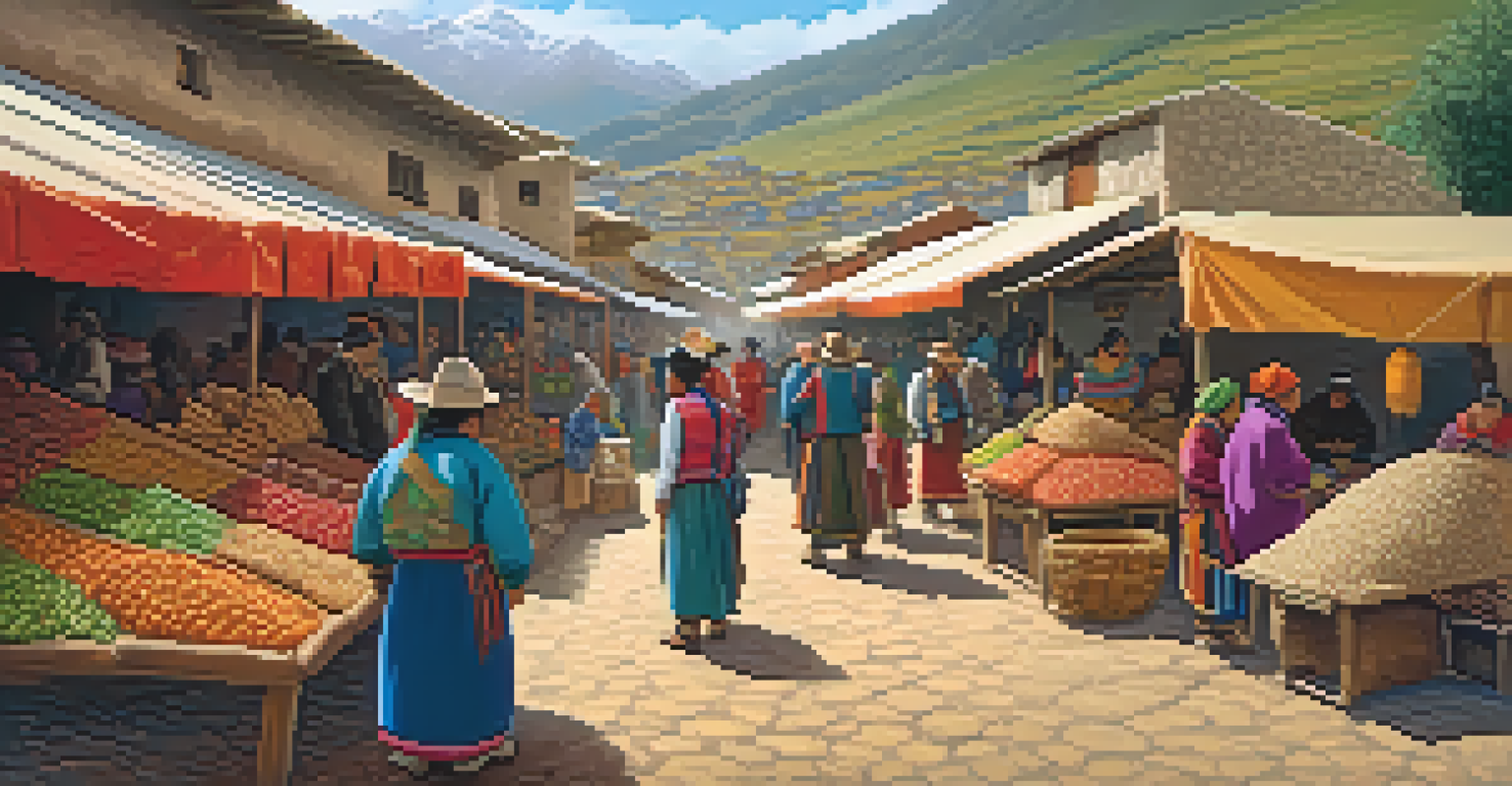The Role of the Qhapaq Ñan in Ancient Peruvian Trade

Understanding the Qhapaq Ñan: A Trade Network
The Qhapaq Ñan, or 'Royal Road', was an extensive network of roads and trails that spanned the Andes Mountains in Peru. This system was not merely a transportation route; it was the backbone of trade and communication for the Inca Empire. Connecting various regions, it allowed for the efficient movement of goods, people, and information across vast distances.
The road is a river of movement, linking disparate communities and fostering trade and cultural exchange.
Imagine a bustling highway today, where goods travel seamlessly from one city to another. Similarly, the Qhapaq Ñan enabled merchants and traders to transport items like textiles, ceramics, and agricultural products. It was crucial for integrating diverse cultures and economies, making trade not only possible but thriving.
In essence, the Qhapaq Ñan was the lifeline of the Inca civilization, ensuring that resources were shared and exchanged. This intricate road system played a pivotal role in establishing the economic structure that allowed the empire to flourish.
Key Trade Goods Along the Qhapaq Ñan
The trade routes of the Qhapaq Ñan facilitated the exchange of various goods that were essential to the Inca way of life. Among the most traded items were textiles made from alpaca and llama wool, which were highly valued for their warmth and durability. These textiles were crafted in different regions, each with unique styles and techniques.

In addition to textiles, agricultural products like potatoes, maize, and quinoa were transported across the network. For instance, the coastal areas specialized in fishing and agriculture, while the highlands focused on potato cultivation. This diversity in production created a rich tapestry of trade, where each region contributed its strengths.
Qhapaq Ñan: Trade Lifeline of the Incas
The Qhapaq Ñan was an extensive road network that facilitated trade, communication, and cultural exchange across the Inca Empire.
Moreover, precious metals like gold and silver were also significant trade items, often used in ceremonial contexts. Thus, the Qhapaq Ñan not only facilitated the physical movement of goods but also reinforced the cultural and economic exchanges that defined the Inca Empire.
The Role of Chasquis in Trade Communication
An essential feature of the Qhapaq Ñan was the chasquis, or runners, who acted as messengers across the vast network. These agile individuals were trained to sprint between way stations, delivering messages and goods swiftly. Imagine a modern-day courier, but traversing rugged mountain paths instead of city streets.
Trade is not just about goods; it is about the sharing of experiences and the building of connections.
Chasquis carried quipu, a system of knotted strings used for record-keeping, which helped manage trade transactions and logistics. This method allowed for the efficient organization of trade routes and schedules, ensuring that goods were exchanged in a timely manner. Their speed and reliability were crucial for maintaining the flow of trade.
Thus, the chasquis were not just messengers but vital cogs in the machinery of the Inca economy. Their role highlights how communication and trade were intricately linked, enabling the empire to function smoothly despite its geographical challenges.
Cultural Exchange Along the Qhapaq Ñan
The Qhapaq Ñan was more than just a trade route; it functioned as a corridor for cultural exchange among the diverse peoples of the Andes. As merchants and travelers moved along the paths, they brought with them not only goods but also ideas, traditions, and customs. This interchange enriched the cultural fabric of the Inca Empire.
For example, festivals, agricultural techniques, and even religious practices were shared among different communities. Imagine a potluck where each participant brings a unique dish; similarly, the Qhapaq Ñan enabled a blending of cultures that enhanced the social landscape of the region. Such exchanges fostered unity and understanding among various ethnic groups.
Diverse Goods Fueled Inca Economy
Essential trade goods like textiles, agricultural products, and precious metals were exchanged along the Qhapaq Ñan, enriching the Inca economy.
In this way, the Qhapaq Ñan served as a bridge that connected disparate communities, allowing for a rich mingling of cultures. This cultural dynamism was essential for the cohesion of the empire, demonstrating that trade is not solely about goods, but also about the sharing of human experiences.
The Impact of Geography on Trade
The geography of Peru, with its diverse landscapes ranging from coastal plains to high mountain ranges, played a significant role in shaping trade along the Qhapaq Ñan. The road system was strategically designed to navigate these varying terrains, allowing traders to connect remote areas with more populated centers. This adaptability was crucial for ensuring consistent trade routes.
For instance, the high-altitude regions were known for their unique agricultural products, while the coastal areas offered fish and salt. The Qhapaq Ñan enabled these regions to trade their specialties, creating a balanced economy that relied on the strengths of different geographical areas. It's like a well-coordinated team where each player brings a unique skill set to the game.
Thus, the geographical diversity of Peru not only influenced the types of goods traded but also dictated how trade was conducted. The careful planning of the Qhapaq Ñan allowed the Inca Empire to maximize the potential of its resources, making it a model of economic interdependence.
Trade Regulations and Governance
With trade being such a vital aspect of the Inca economy, governance and regulation along the Qhapaq Ñan were paramount. The Inca Empire established laws and guidelines to oversee trade practices, ensuring fairness and efficiency. This regulatory framework was crucial in preventing disputes and maintaining order in trade transactions.
For instance, the state imposed taxes on goods exchanged, which helped fund public projects and military endeavors. Think of it like sales tax today, where a small percentage of each transaction contributes to the community. This system not only supported the empire's infrastructure but also ensured that trade benefited all levels of society.
Chasquis: Essential Trade Messengers
Chasquis, or runners, played a vital role in the Qhapaq Ñan by swiftly delivering messages and goods, ensuring efficient trade communication.
Furthermore, the presence of officials at key points along the Qhapaq Ñan helped monitor the flow of goods and enforce regulations. This governance structure was essential for sustaining trade, highlighting the intricate relationship between regulation and economic prosperity.
The Decline of the Qhapaq Ñan and Its Legacy
Despite its immense importance, the Qhapaq Ñan faced challenges that led to its decline following the Spanish conquest in the 16th century. As the Inca Empire fell, so too did the structured trade networks that once flourished along the roads. This disruption drastically altered the economic landscape of the region.
However, the legacy of the Qhapaq Ñan endures, as it laid the groundwork for modern trade routes in the Andes. Today, remnants of this ancient road system can still be seen, serving as a testament to the ingenuity of the Inca civilization. It's akin to how ancient highways influence today's transportation networks.

Moreover, the Qhapaq Ñan is now recognized as a UNESCO World Heritage site, underscoring its cultural and historical significance. The lessons learned from this ancient trade network continue to inspire modern discussions about trade, sustainability, and cultural exchange, reminding us of the interconnectedness of human societies.